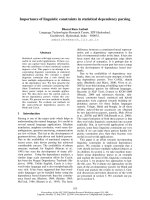The Importance of Eye Contact in the Classroom
Bạn đang xem bản rút gọn của tài liệu. Xem và tải ngay bản đầy đủ của tài liệu tại đây (52.62 KB, 2 trang )
The Importance of Eye Contact in the
Classroom
Teachers often complain about discipline, about lack of attention, about the use of L2 in the
classroom and many other problems, many of which amount to a breakdown in
communication between teacher and students or between students themselves. It is well
known that speech is only one part of communication, yet teachers often forget about or
underestimate the importance of non-verbal communication in their own and their students'
performance. One aspect of non-verbal communication is the use of the eyes to convey
messages. The eyes are a powerful tool for both the teacher and the learner, yet much
classroom time is spent with eyes firmly fixed on the book, the board, the floor, the
window, or roaming randomly around the teaching and learning environment.
Teachers working in all disciplines in secondary schools have always been advised to
develop 'the look' as part of their teaching persona. 'The look' ranges from 'be quiet please',
through 'I'm not going to tell you again' to 'don't mess with me, sonny', and in this respect is
seen as having a disciplinary function. Meanwhile, the business world has accepted eye
contact as an important component of achieving success in giving presentations and
improving rapport between representative and client, while these days it is possible to find
many websites offering advice on how to forge personal relationships through the judicious
use of eye contact. Researchers and practitioners in Neuro-Linguistic Programming (NLP)
have brought the notion of body language and eye contact back to the attention of language
teachers, but largely in the context of providing clues to the nature of the learner rather than
in terms of a teaching tool. We have recently had the pleasure of observing English
language classes at the Izmir University of Economics, and have seen a lot of pairs of eyes
performing a lot of functions.
Here are some of the things that we have been reminded of or learnt anew:
• 'The look' still works, but don't overdo it or you will become a caricature of
yourself.
• Establishing a management role in the classroom involves eye contact from the
outset. Be in your classroom before your learners, and welcome them individually
with a combination of eye contact and their name as they enter the room.
• Talk to your learners, not to the book, the board or the screen.
• Eyes can set the tone of a lesson. As the lesson starts, walk around the room
looking to check whether the learners are ready -- books out, pens and paper handy,
mobile phones off. If not, eye contact should suffice to rectify the situation.
• Try teaching part of a lesson without saying anything. This should remind you of
how important paralinguistics is as well as helping to control your teacher talking
time.
• Good eye contact does not mean staring or gazing. Many learners are likely to find
this uncomfortable and consequently avert their own eyes and lose concentration.
• Neither does good eye contact mean eyes darting from learner to learner around the
room -- this has no effect whatsoever. It is recommended that there should be three
to five seconds eye contact for non-verbal communication to take place.
• Watch your learners as well as listen to them, particularly while they are
performing tasks. Look for signs of being bored or being lost.
• Encourage your learners to make eye contact while they are working together in
pairs or groups. Start by training them to listen to each other using non-verbal
responses only.
• Research shows that there is a strong link between the amount of eye contact people
receive and their degree of participation in group communication -- in the number
of turns taken in a group conversation for example.
• The NLP approach to eye contact is holistic and individualistic, but is soundly
based on the premise that good eye contact increases rapport.
• Save time and effort with specific messages delivered by eye and facial expression.
Show praise, encouragement often, and disapproval occasionally. Remind learners
that they ought to know an answer or that they could provide a response if they
tried.
• Use eye contact as a correction technique.
• Nominate and invite responses by eye. If the nominee is not watching, someone
will give him/her a nudge.
• Eye contact is, fundamentally, time and effort saving.
Much of the above is likely to seem transparently obvious, only natural, and an aspect of
human behaviour either innate or developed over time. But watch yourself, watch your
colleagues, and watch your learners!









